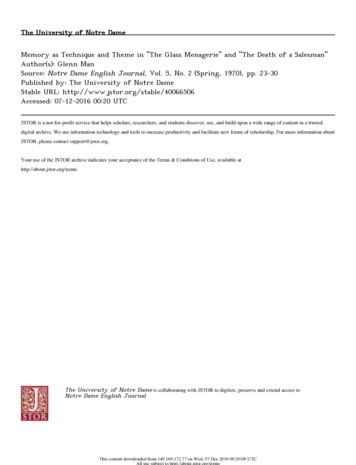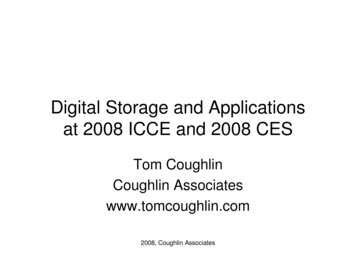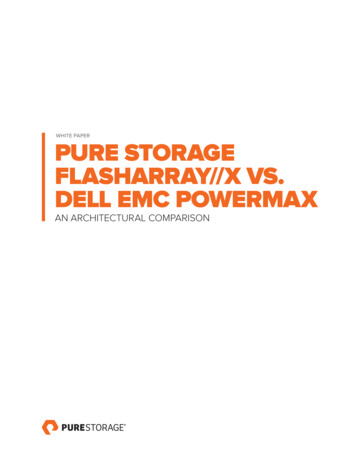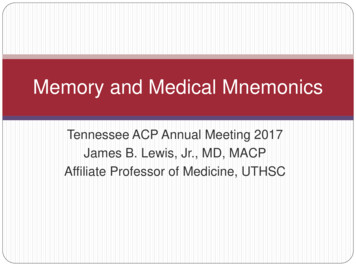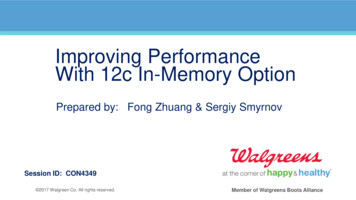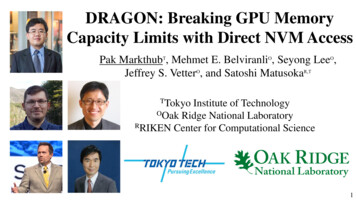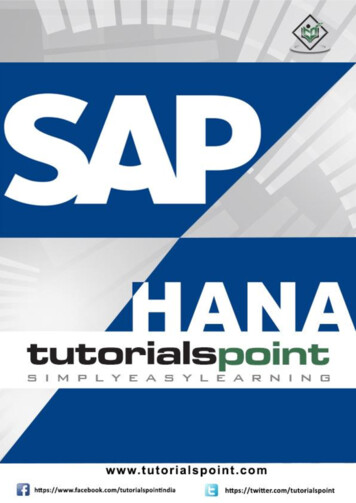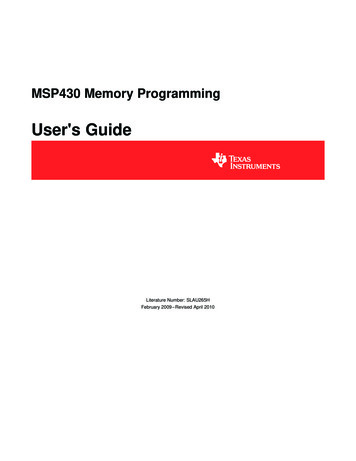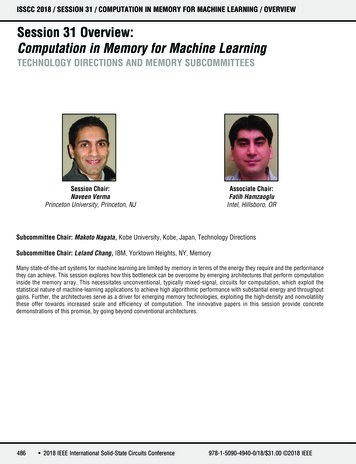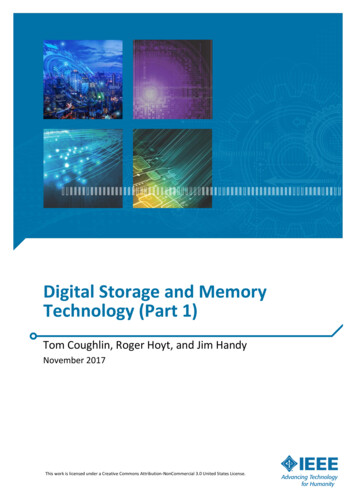
Transcription
Digital Storage and MemoryTechnology (Part 1)Tom Coughlin, Roger Hoyt, and Jim HandyNovember 2017This work is licensed under a Creative Commons Attribution-NonCommercial 3.0 United States License.
This report is the first of a two-part series for the IEEE discussing developments indigital storage technology. In this first part, the opening section looks at developmentsin basic digital storage and memory technology at the storage and memory devicelevel, extending to interfaces and protocols for connecting storage systems such ashard disk drives (HDDs) and solid-state drives (SDDs) to other computer hardware tocreate storage systems.The second section discusses developments in storage systems and software tomanage that storage. Developments and expected developments in semiconductormemories are examined as well as the move from volatile to nonvolatile memory,including flash memory and emerging nonvolatile memories such as threedimensional (3-D) XPoint and magnetic random-access memory (MRAM). Currentand expected developments in HDD and magnetic tape technology as well as opticalstorage technology are reviewed. Important factors that prompt storage-systemdevelopers to use one or more of these storage technologies to create workingstorage systems are described.The final section looks at the business of storage and memory, comparing capitalequipment costs, industry consolidation trends, regional developments, andemployment, ending with recommendations for industry professionals to remainrelevant and employed during this time of intense change in the memory and storageindustry.2
Table of ContentsTable of Contents . 3Storage and Memory Device Developments. 5Hard-Disk Drives . 6Magnetic Tape . 8Optical Storage . 9Flash Memory . 10Emerging Nonvolatile Memory Technologies . 12Choosing Storage Technologies. 13Response time . 14Touch rate . 15Touch rate versus response time . 15Technology regions . 16I/O object size curve . 17Digital Storage Interfaces, Protocols, and Form Factors . 20Device Interfaces: SATA, SAS, NVMe, and the Memory Channel . 20SATA . 20SAS. 22NVMe over PCIe. 22Memory Channel . 23Network Interfaces: Ethernet, Infiniband, and NVMe-oF . 25Ethernet . 25InfiniBand . 26NVMe over fabric . 26Business Trends for Storage and Memory Devices. 27Capital Investments, Regional Developments, and Industry Consolidation . 27Recommendations for Industry Professionals. 28How IEEE Can Help You Stay Employable. 29Biographies . 313
Table of FiguresFigure 1. Data created compared to data stored. (Reproduced by Tom Coughlin from theSeagate Technology keynote talk at the 2017 Flash Memory Summit.) . 5Figure 2. The ASTC HDD areal density road map. (Courtesy of ASTC.). 7Figure 3. The LTO magnetic tape road map. (Courtesy of the LTO Consortium.) . 9Figure 4. The Blu-ray optical disc road map. . 10Figure 5. The NAND flash technology road map. (Courtesy of TechInsights.) . 11Figure 6. A smart modular nvNITRO NVMe storage device. (Courtesy of Everspin.) . 12Figure 7. Memory-storage hierarchy versus performance. (Objective Analysis, 2017.). . 14Figure 8 The touch rate versus response time, indicating various types of uses. . 16Figure 9. The storage technology regions overlaid on the touch rate/response time chart inFigure 8. . 17Figure 10. The touch per year and response time for 100% random I/O in a 4-TB capacityHDD. . 18Figure 11. Touch per year and response time for 4-TB capacity HDD, LTO tape, and Blu-raydiscs. . 19Figure 12. History and projections for annual shipped capacity of magnetic tape, SSDs (withNAND flash), and HDDs. (Coughlin Associates, 2017.). 20Figure 13. SATA cable and connector. (Courtesy of SATA-IO.). . 21Figure 14. An M.2 form factor NVMe storage device. (Courtesy of Samsung.). . 23Figure 15. An NVDIMM-N block diagram. (Objective Analysis, 2017.). . 24Figure 16. A Samsung flash factory in Xi’an, China. (Courtesy of Samsung.) . 284
Storage and Memory Device DevelopmentsInternational Data Corporation has estimated that, in 2016, 16 zettabytes (ZB, 10 tothe 21st power bytes) of data were created and that this amount of generated data willincrease to 163 ZB by 2023. At the same time, the shipped storage capacity for HDDs,magnetic tape, and flash memory was about 4.3% of the estimated generated ZB in2016 (0.7 ZB) and is expected to be between 2 and 3% of the estimated total ZBgenerated in 2023. This is because most of the data generated are meant to beprocessed and used, rather than stored as raw data. For instance, sensor data fromthe Internet of Things (IoT) devices or driving assistance in cars are meant to beprocessed to make real-time decisions and require memory and storage to enable thisprocessing. The results of this processing might be stored for a longer time. Figure 1shows a visual representation of estimated data generated and stored out to 2025.Figure 1. Data created compared to data stored. (Reproduced by Tom Coughlinfrom the Seagate Technology keynote talk at the 2017 Flash Memory Summit.)Thus, different types of nonvolatile memory and digital storage are required fordifferent applications. Further, more than one technology might be used together withothers to achieve the optimal tradeoff in cost versus performance. This results in ahierarchy of memory and storage technologies.Digital storage and memory technologies began in the 1950s with the introduction ofdigital magnetic tape, magnetic HDDs, magnetic drums, and various early memorytechnologies. Since their introduction, digital storage and nonvolatile memory havebroadened to encompass a wide range of technologies and applications. Currenttechnologies include solid-state nonvolatile flash memory based on NANDsemiconductor cells, ferroelectric, MRAM, magnetic recording on rigid disks and tape,and a number of different optical storage technologies.5
The list of potential additional emerging digital storage and nonvolatile memorytechnologies that have already or may soon enter the mainstream continues toincrease, including solid-state phase-change memory (PCM) such as Intel’s Optane,hybrid flash/disk drives, various resistive memory storage, spin-torque MRAM, andother magnetic spin-based memories and optical holographic-based storage.Hard-Disk DrivesMagnetic-recording-based HDD technology continues to play a large and importantrole in mass data storage. With about 424 million shipped units in 2016 and expectedvolumes slowing to 317 million units by 2022, HDD technology continues as a costeffective, nonvolatile online storage solution (particularly for cooler long-term datastorage). Price reductions and cost efficiencies led to vertical integration of all but oneof the remaining three HDD manufacturers (Western Digital, Seagate Technology, andToshiba) and the further consolidation of head, disk, electronics, and mechanicalsuppliers.Enablers for continued HDD areal density and performance improvements includecurrent perpendicular-to-plane giant magnetoresistance (CPP GMR) heads, heatassisted magnetic recording, microwave-assisted magnetic recording, shingledmagnetic writing, bit patterned media, advanced signal processing, and improvedsecurity through disk data encryption.HDDs are gradually declining in the personal computer market although, for users whoneed 1-TB or higher capacity, they are still the preferred storage media because oftheir lower cost. These HDDs may be combined with an SSD or act as a hybrid HDDwith embedded flash memory to improve the overall drive performance. The maingrowth in HDDs will be for inexpensive storage for content repositories that need lowerlatencies than magnetic tape and optical library systems (note that HDD costs are nowlower than US .04 per raw gigabyte). While total unit shipments are expected todecline going forward, the consolidation in the industry and the growing importance ofenterprise HDD storage will limit the decline in total HDD revenue (and profit).The Advanced Storage Technology Consortium (ASTC), consisting of representativesfrom HDD companies as well as major HDD component vendors, creates annual roadmaps for HDD technology. In particular, the ASTC charts the areal density of magneticrecording over time. The areal density is the number of bits that can be stored on aunit of disk surface and the product of the average track density on a disk surfacetimes the average linear density around those tracks. Figure 2 shows the 2016 ASTCHDD technology road map.Perpendicular magnetic recording (PMR) was introduced into HDDs in 2004. At thattime, HDD areal density growth was over 100% annually (so you could buy over twicethe storage capacity for the same sized disk drive from one year to the next). Today,nearing the end of the density improvements possible with perpendicular recordingalone, annual areal density growth is between 10 and 15%. HDD areal densities willneed to continue growing to retain their cost advantage over other storagetechnologies.6
Figure 2. The ASTC HDD areal density road map. (Courtesy of ASTC.)To continue areal density growth, new technologies must be used in HDDs. Shingledmagnetic recording writes adjacent tracks overlapping one another (like shingles on aroof) to increase the track density, while two-dimensional magnetic recordingcombines this with multiple read heads on adjacent tracks. These technologies canincrease the areal density, but they are best used for HDDs that write data only oncebecause overwriting previous data involves a multistep process that increases thewrite time of the drive. For applications that need to rewrite often, other approaches toincrease areal density must be used.Up until October 2017, this additional improvement was expected to be what is calledheat-assisted magnetic recording (HAMR), where a laser is used to allow the HDDwrite transducer to write on very-high-coercivity magnetic recording media on a disksurface. The high coercivity allows writing higher linear densities, but conventionalwrite heads can’t produce sufficient field to write this media. The heat of the laserlowers the media coercivity, so the write head can write on the media. HAMR is theapproach that Seagate Technology has announced it will use for the next generationof HDDs, with engineering samples available in 2018 and products in 2019.In October 2017, HGST, a division of Western Digital, announced it would manufactureHDDs that used another technology to help write heads write on high-coercivity media.HGST plans to put a spin-t
5 Storage and Memory Device Developments International Data Corporation has estimated that, in 2016, 16 zettabytes (ZB, 10 to the 21st power bytes) of data were created and that this amount of generated data will increase to 163 ZB by 2023. At the same time, the shipped storage capacity for HDDs, magnetic tape, and flash memory was about 4.3% of the estimated generated ZB in 2016 (0.7 ZB) and .
